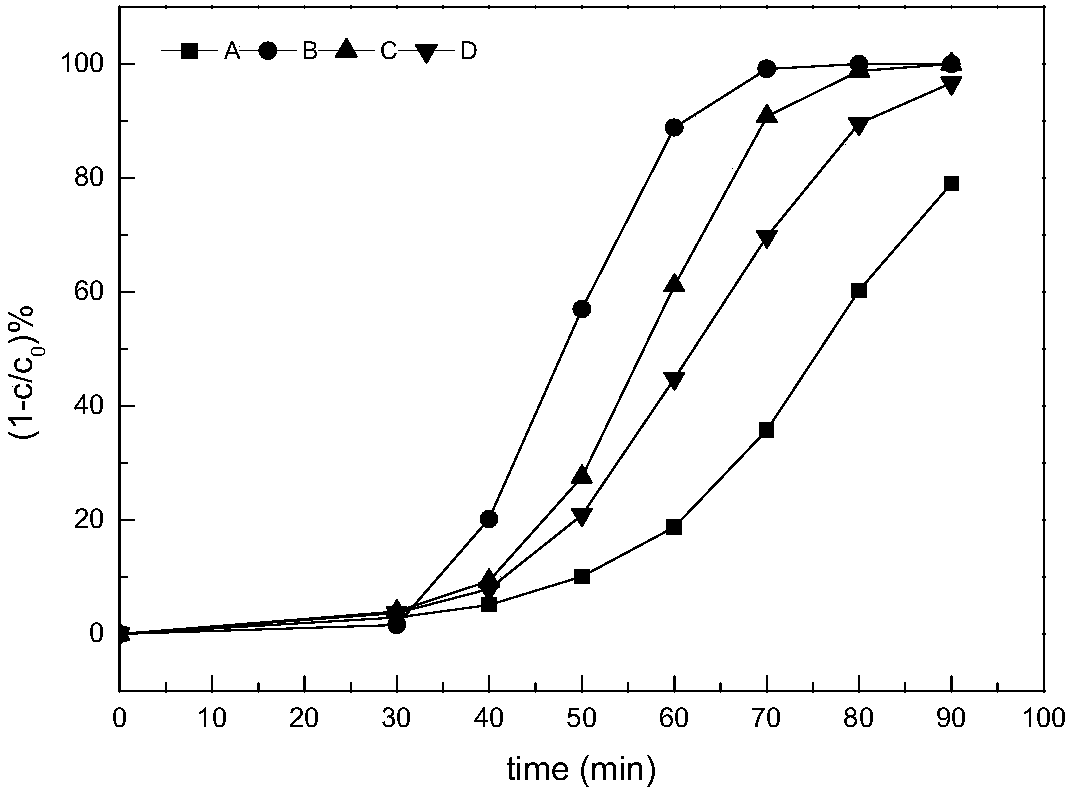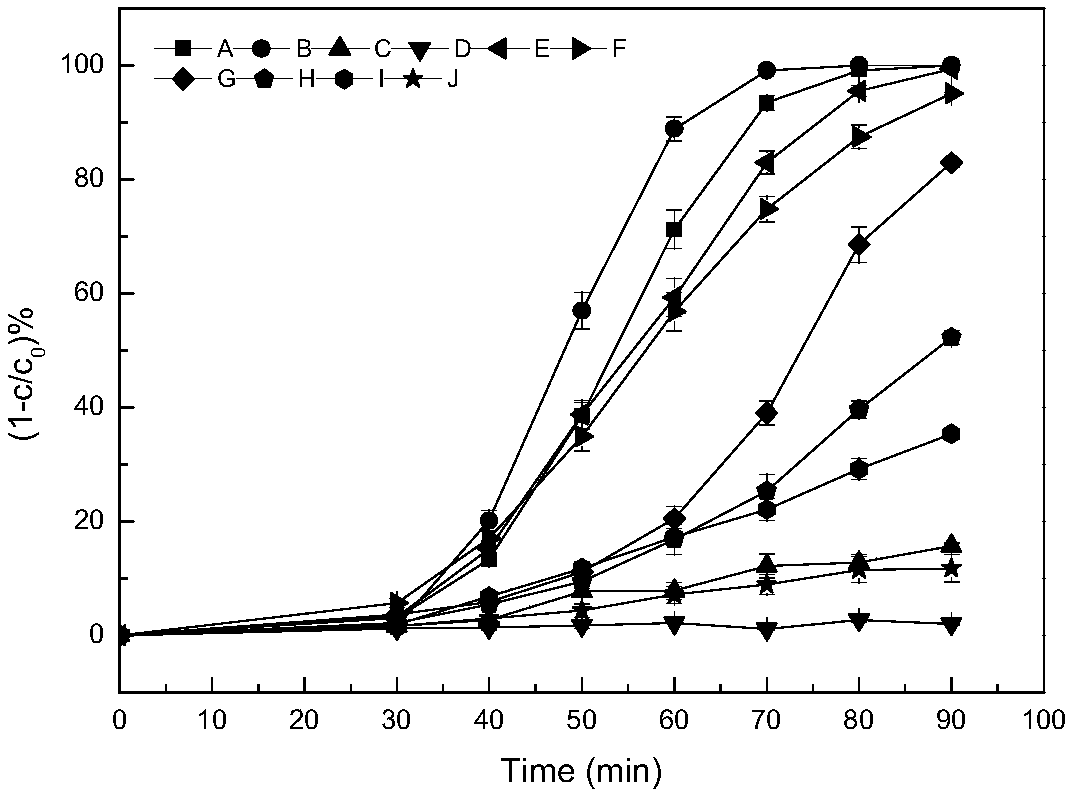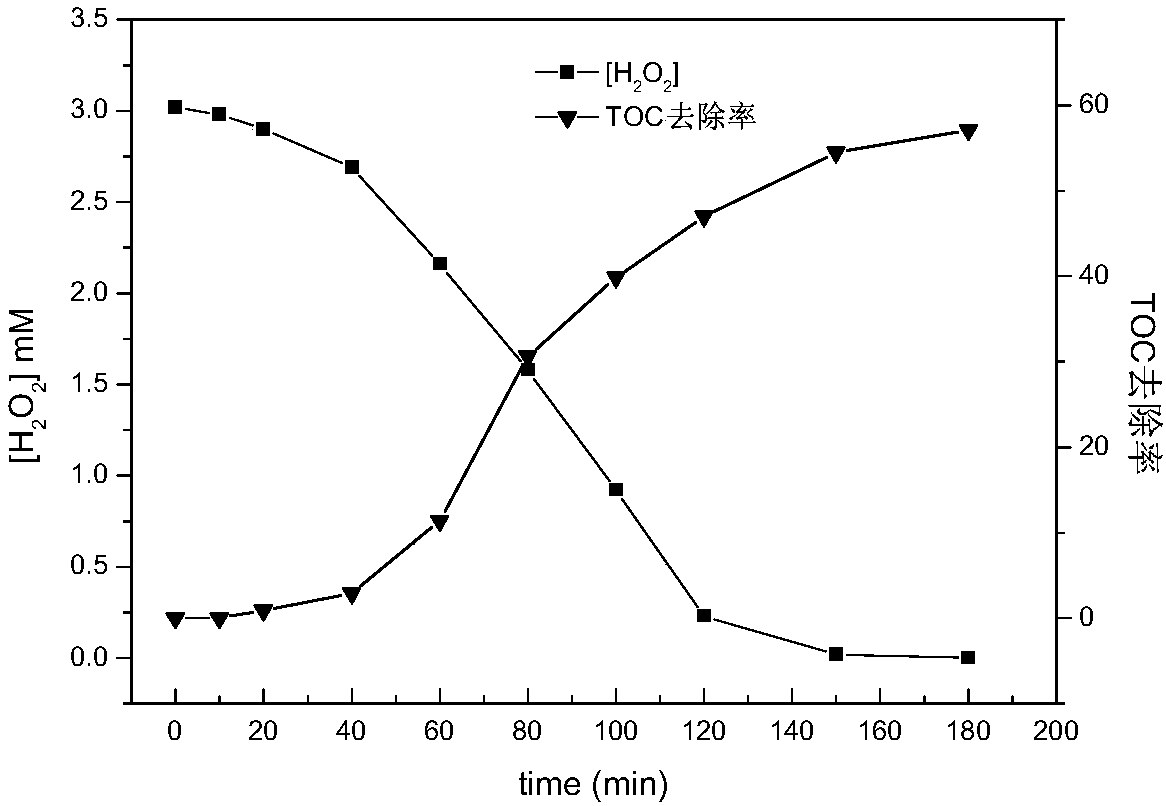Ferroferric oxide @rGO@MIL-100 (Fe) photo-Fenton catalyst and preparation and application thereof
A technology of ferroferric oxide and catalyst, which is applied in the direction of physical/chemical process catalyst, organic compound/hydride/coordination complex catalyst, chemical instrument and method, etc., which can solve the problem of increasing water treatment operation cost, catalyst loss, increase Operating costs and other issues, to achieve the effect of excellent visible light catalytic activity, good affinity, and a wide range of applications
- Summary
- Abstract
- Description
- Claims
- Application Information
AI Technical Summary
Problems solved by technology
Method used
Image
Examples
Embodiment 1
[0055] 1) Preparation of ferroferric oxide by solvothermal method
[0056] Add 1.35g of ferric chloride hexahydrate to 40ml of ethylene glycol, stir for 30min with magnetic force, then add 3.6g of sodium acetate and 1.0g of polyethylene glycol, stir with magnetic force for 30min, pour into a stainless steel polyethylene reaction kettle, at 200℃ After reacting for 8 hours, it was washed several times with absolute ethanol, and dried at 60°C for 6 hours to obtain ferric oxide.
[0057] 2) Modified ferric oxide
[0058] Add 0.5ml of 3-aminopropyltriethoxysilane and 0.5g of ferric oxide into 100ml of isopropanol, stir mechanically at 80°C for 24h, recover by magnetic force, and dry at 60°C overnight.
[0059] 3) Preparation of graphene oxide
[0060] Add 2.0g of flake graphite powder, 1g of phosphorus pentoxide and 1g of potassium persulfate to 10ml of concentrated sulfuric acid, stir magnetically at 80°C for 4.5h, separate by suction filtration, and dry overnight; add it to 46m...
Embodiment 2
[0077] Fe 3 o 4 The preparation of @rGO@MIL-100(Fe)(10cycles) photo-Fenton catalyst is the same as Example 1.
[0078] Fe 3 o 4 @rGO@MIL-100(Fe)(10cycles) photocatalytic degradation of 2,4-dichlorophenol: put 100mL of 2,4-dichlorophenol wastewater with a concentration of 50mg / L in the reactor, and adjust the pH of the system to 5.5, add 0.02g Fe 3 o 4 @rGO@MIL-100(Fe)(10cycles) photocatalyst, adsorbed in the dark for 30min to reach equilibrium. Place it under a 500W xenon lamp for 1 hour, measure the change of the concentration of 2,4-dichlorophenol in the system, and obtain the degradation effect of 2,4-dichlorophenol wastewater: the degradation rate reaches 12.16% in 40 minutes.
Embodiment 3
[0080] Fe 3 o 4 The preparation of @rGO@MIL-100(Fe)(10cycles) photo-Fenton catalyst is the same as Example 1.
[0081] Fe 3 o 4 @rGO@MIL-100(Fe)(10cycles) Fenton catalyst degrades 2,4-dichlorophenol: put 100mL of 2,4-dichlorophenol wastewater with a concentration of 50mg / L in the reactor, and adjust the pH of the system is 5.5, add 0.02g Fe 3 o 4 @rGO@MIL-100(Fe)(10cycles) Fenton catalyst, adsorption in the dark for 30min to reach equilibrium. After reacting for 1 hour in the dark, the change of the concentration of 2,4-dichlorophenol in the system was measured, and the degradation effect of 2,4-dichlorophenol wastewater was obtained: the degradation rate reached 1.09% in 40 minutes.
PUM
 Login to View More
Login to View More Abstract
Description
Claims
Application Information
 Login to View More
Login to View More - R&D
- Intellectual Property
- Life Sciences
- Materials
- Tech Scout
- Unparalleled Data Quality
- Higher Quality Content
- 60% Fewer Hallucinations
Browse by: Latest US Patents, China's latest patents, Technical Efficacy Thesaurus, Application Domain, Technology Topic, Popular Technical Reports.
© 2025 PatSnap. All rights reserved.Legal|Privacy policy|Modern Slavery Act Transparency Statement|Sitemap|About US| Contact US: help@patsnap.com



